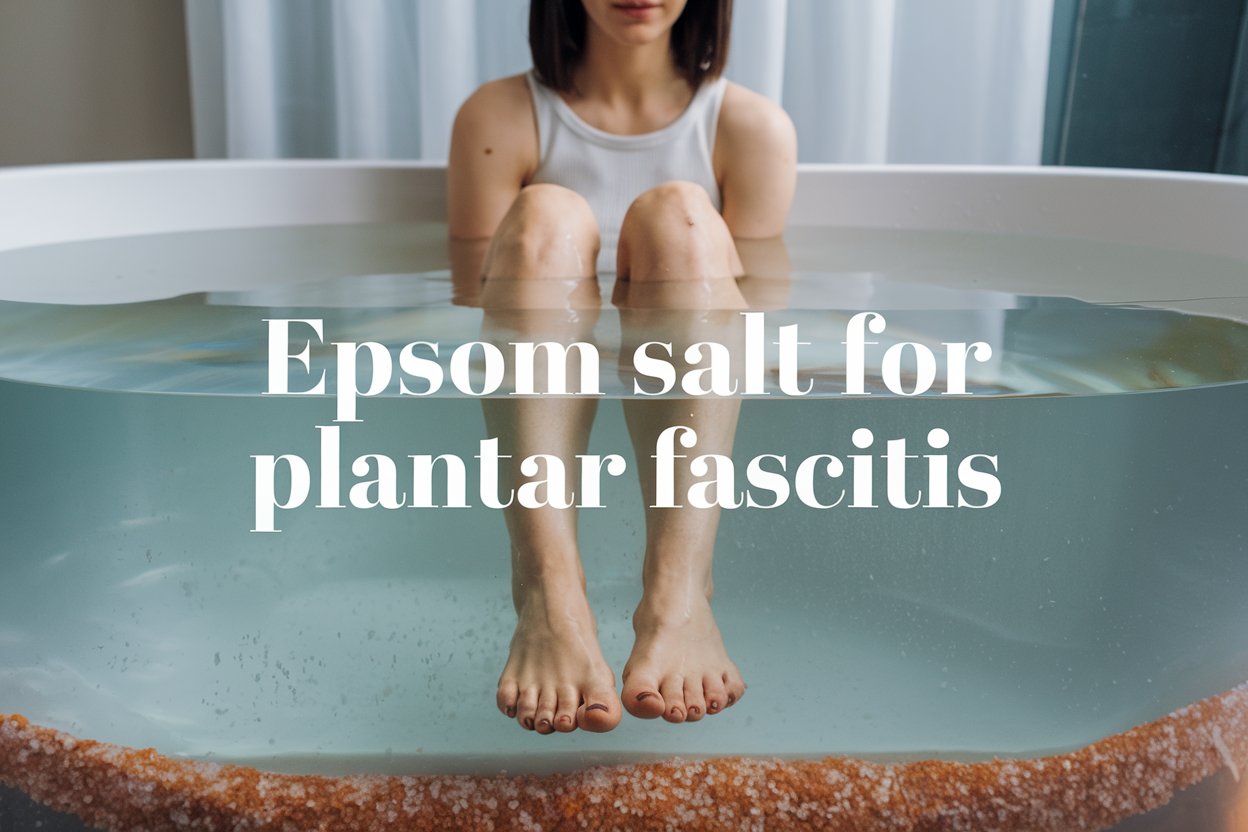Epsom Salt for Plantar Fasciitis Relief Tips

Imagine ending a long day on your feet, only to feel a sharp pain in your heels. This is a common problem for the two million Americans who suffer from plantar fasciitis each year. Many have found relief with Epsom salt, a simple and affordable option. It’s known for its epsom salt benefits in easing foot pain and swelling.
Research suggests magnesium can help with pain. Even though some studies have mixed results, many people find Epsom salt foot baths helpful. Just think about soaking your feet after a long day, feeling the pain melt away in a warm bath. Adding a few tablespoons of Epsom salt to your bath could be just what you need. It turns a simple bath into a healing experience, offering comfort in your busy life.
Table of Contents
Understanding Plantar Fasciitis
Plantar fasciitis is a common condition that causes foot pain, especially in the heel. It happens when the plantar fascia, a strong tissue band, gets inflamed. This tissue connects the heel bone to the toes, helping to keep the foot’s arch stable.
Many people can get plantar fasciitis, especially those with flat feet or high arches. Standing for long periods on hard surfaces can make it worse. In the U.S., it’s a top reason for heel pain, with runners facing about two million cases each year.
Things like wearing the wrong shoes, being overweight, and getting older can increase the risk. Athletes and people who are active are more likely to get it. While painkillers like ibuprofen can help with swelling, trying holistic methods might offer better long-term relief.
Talking often with doctors about foot health is key to managing plantar fasciitis well. For more on recognizing early signs of health issues, check out this link.
What is Epsom Salt?

Epsom salt is also known as magnesium sulfate. It’s a mineral compound known for its soothing effects. People use it as a home remedy for pain, especially for foot issues like plantar fasciitis. When you mix it with warm water, it releases magnesium. This helps relax muscles and reduce swelling.
Many people find foot pain relief by soaking in Epsom salt baths. It’s an affordable and easy option since you can find Epsom salt in most drugstores and grocery stores in the U.S.
Studies and stories show that using Epsom salt regularly can help with inflammation. For those with plantar fasciitis, soaking feet in magnesium sulfate improves blood flow. It also reduces pain and makes feet feel better.
To make a good foot soak, mix two tablespoons of Epsom salt with one quart of warm water. This helps relax tired feet and supports healing. Adding essential oils like peppermint or lavender can also help with inflammation and relaxation.
While Epsom salt is great for foot pain, be careful if you have certain health issues. Avoid it if you have diabetic feet or open wounds. Generally, soaking in Epsom salt can help with foot pain and improve overall health.
Epsom Salt for Plantar Fasciitis: A Natural Remedy
Epsom salt is full of magnesium and sulfate, which helps people with plantar fasciitis. This condition makes the heel and sole of the foot hurt and swell. It often happens because of bad shoes or foot problems. Many people use Epsom salt foot soaks as a cheap and easy way to feel better.
Stories from people who use Epsom salt soaks show it helps a lot. They say it makes the pain and swelling go down. Soaking your feet in warm water with Epsom salt can also make you feel more relaxed. Adding things like peppermint or lavender oil makes the soak even better. It helps with swelling and makes you feel calm.
It’s easy to make an Epsom salt foot soak. Just mix two tablespoons of Epsom salt with warm water. Soak your feet for 15-20 minutes, two times a week, for great results. You’ll see better blood flow, less muscle cramps, and better nerve function. This natural way to help your feet also makes them healthier over time.
But, there are things to watch out for with Epsom salt soaks. Don’t soak your feet if you have open cuts on them to avoid getting an infection. Even though it helps, it shouldn’t replace what your doctor says you should do. For real relief from plantar fasciitis, you should also stretch and wear good shoes.
| Benefit | Description |
|---|---|
| Reduces Inflammation | Aids in lowering swelling and discomfort associated with plantar fasciitis. |
| Promotes Relaxation | Warm water and magnesium help soothe sore muscles and relieve stress. |
| Boosts Circulation | Enhances blood flow in the feet, promoting healing and overall foot health. |
| Improves Nerve Function | Magnesium plays a vital role in nerve health and function for better foot mobility. |
| Available and Affordable | Epsom salt is inexpensive and can easily be found at health shops or pharmacies. |
Benefits of Epsom Salt for Foot Pain

Epsom salt is known for helping with foot pain relief, especially for plantar fasciitis sufferers. It’s made mostly of magnesium and sulfate, which are good for your body. These minerals help reduce inflammation, making Epsom salt great for self-care.
Many people say Epsom salt foot soaks help with pain from inflammation and muscle cramps. Adding Epsom salt to your bath can also help with circulation, which is key for healing. Just two tablespoons of Epsom salt in warm water can make you feel relaxed and help with pain.
If you have conditions like arthritis or gout, Epsom salt soaks might help too. Warm water and magnesium sulfate can ease pain and help with healing. People also report less pain from athlete’s foot and toenail fungus after using it.
Regular Epsom salt foot soaks can make your feet healthier. They can reduce odor and soften rough skin. Adding essential oils like peppermint or lavender can make the soak even better. These oils help with relaxation and pain relief.
To learn more about foot health and treatments for male infertility, visit this resource. Epsom salt foot soaks are a great option for managing pain naturally.
How Epsom Salt Helps Reduce Inflammation
Epsom salt is known for its ability to reduce inflammation and provide pain relief. It contains magnesium, a mineral that helps relax muscles and reduce tension. Using Epsom salt in foot soaks can lower cortisol levels, a stress hormone linked to inflammation. Many people find relief from plantar fasciitis symptoms by adding Epsom salt to their routine.
Soaking feet in Epsom salt helps reduce inflammation in several ways:
- Magnesium helps with muscle and nerve function, making the body more relaxed.
- Foot baths improve circulation, which helps reduce swelling and discomfort.
- Feeling relaxed from the soak lowers stress, which also helps reduce inflammation.
To get the best results, soak your feet in epsom salt for inflammation twice a week. Use half a cup of Epsom salt in warm water for 15-20 minutes. This simple routine not only gives immediate pain relief but also helps with long-term recovery from foot pain.
You can make the experience even better by adding essential oils like lavender or peppermint. These oils can enhance the soothing effects and make the soak more enjoyable.
| Benefit | Mechanism |
|---|---|
| Reduce Inflammation | Magnesium helps relax muscles, alleviating tension. |
| Improve Mobility | Enhanced circulation reduces swelling and promotes healing. |
| Stress Relief | Soaking reduces cortisol levels, associated with inflammation. |
| Enhanced Pain Relief | Regular foot soaks help manage foot pain and discomfort. |
Using Epsom salt for inflammation and regular foot soaks can greatly improve life for those with plantar fasciitis. This easy and affordable remedy offers pain relief through a simple, relaxing process.
Preparing an Epsom Salt Foot Soak
Getting ready for an Epsom salt foot soak is easy. You just need a big basin or tub and some epsom salt. Fill the basin with warm water that won’t burn your skin.
Put two to three tablespoons of epsom salt into the water. Let it dissolve fully. Then, put your feet in the solution and relax for 10 to 15 minutes. Doing this twice a day can help with plantar fasciitis symptoms.
Epsom salt foot soaks can reduce swelling, ease muscle cramps, and help you relax. They offer quick relief and support your foot health. Enjoy your soak as part of your self-care routine.
Adding Essential Oils to Your Epsom Salt Soak
Adding essential oils to your Epsom salt soak can make it even better for foot pain. Warm water, Epsom salt, and essential oils together create a bath that relaxes and helps with pain. This is great for conditions like plantar fasciitis.
Popular Essential Oils for Relief
Some essential oils have anti-inflammatory properties, making them perfect for foot pain relief. Here are some top choices:
- Lavender Oil – It’s calming and can ease muscle tension and anxiety.
- Peppermint Oil – This oil cools down and boosts circulation, helping with pain relief.
- Tea Tree Oil – It has antibacterial properties, which can fight infections in the feet.
How to Mix Essential Oils with Epsom Salt
Here’s how to mix essential oils with Epsom salt for your soak:
- Mix two tablespoons of Epsom salt with two to three drops of your chosen essential oil in a small bowl.
- Stir well to spread the essential oil evenly.
- Add this mix to a basin with one quart of warm water.
- Soak your feet for 15 to 20 minutes to enjoy the benefits.
These natural ingredients can help heal plantar fasciitis. For more ways to manage this condition, check out other home remedies that focus on care and physical health.
| Essential Oil | Key Benefits |
|---|---|
| Lavender | Calming, reduces stress and tension |
| Peppermint | Cooling effect, improves circulation |
| Tea Tree | Antimicrobial, prevents infections |
Frequency and Duration of Epsom Salt Soaks
Adding Epsom salt soaks to your self-care can help with plantar fasciitis. Aim for soaking two to three times a week. Each soak should last 10 to 15 minutes. This helps reduce inflammation and pain while making you feel relaxed.
Being consistent with soak time is key to getting the most benefits. Regular soaks not only ease pain but also improve foot health. When used with other treatments, Epsom salt soaks can speed up healing from plantar fasciitis. It’s important to follow best practices for soaking, like water temperature and salt amount.
Warm water and Epsom salt work together to ease discomfort. If you want to learn more about improving foot health, check out this resource on sexual wellness and well-being. Regularly practicing these soaks can make managing plantar fasciitis easier.
| Soak Frequency | Soak Duration | Pain Relief Benefits |
|---|---|---|
| 2-3 times weekly | 10-15 minutes | Reduces inflammation |
| Regular use | Consistent monitoring | Enhances foot health |
| Combined with other treatments | As needed | Speeds up recovery |
Complementary Home Remedies for Plantar Fasciitis
Along with Epsom salt soaks, there are other home remedies for plantar fasciitis. These remedies help with pain and swelling. They also help heal the area, giving you relief from the pain of this condition.
Cold Compresses for Immediate Relief
A cold compress is a great way to ease pain right away. Putting a cold compress on the sore spot for 10-15 minutes can help numb the pain and lessen swelling. This easy trick can be done daily, especially after standing a lot or being active.
Importance of Footwear and Orthotic Support
Wearing the right shoes is key to handling plantar fasciitis. Your shoes should have good cushioning and support for your arch. Using foot orthotics, either custom or over-the-counter, can give more support. This helps your foot stay in the right position and spreads your weight evenly. These steps can make you more comfortable and help with healing.
Considerations and Precautions when Using Epsom Salt
Epsom salt has many benefits, but it’s important to use it safely. Before soaking your feet, check if they are healthy. Don’t soak your feet if you have open wounds or infections. This can make things worse and slow healing.
Foot soak safety is key for people with diabetes or nerve damage. Make sure the water is not too hot to avoid burns. Always check how your skin reacts to the soak to avoid problems.
Some people might get side effects like itching, rashes, or discomfort from soaking. If you have a bad reaction, stop using it right away. Always talk to a doctor if you have any worries about foot soaks.
| Condition | Precautions | Potential Side Effects |
|---|---|---|
| Open Wounds | Avoid foot soaks | Risk of infection |
| Diabetes | Check water temperature | Burns, skin sensitivity issues |
| Nerve Damage | Limit soak duration | Discomfort or skin irritation |
| Fungal Infections | Keep feet dry post-soak | Increased risk in moist environments |
Alternative Treatments for Plantar Fasciitis
If Epsom salt foot soaks don’t help with plantar fasciitis, there are other options. Each method has its own benefits and suits different needs. It’s important to know about various ways to treat plantar fasciitis.
Physical therapy is a great choice for making foot muscles stronger and fixing foot mechanics. Therapists use stretching and strengthening exercises. These focus on the plantar fascia.
Acupuncture can help by working on pressure points. This promotes healing in the body. Red light therapy is also being used and shows good results in studies for easing pain.
Using night splints is another option. These devices stretch the plantar fascia while you sleep, helping it heal. Self-massage techniques and foam rolling can also help by improving circulation and reducing pain. Toe spacers can align your toes and lessen pressure on the plantar fascia.
Here’s a detailed table that summarizes these alternative treatments:
| Treatment | Benefits | Considerations |
|---|---|---|
| Physical Therapy | Strengthens foot muscles, enhances mechanics. | May require multiple sessions for best results. |
| Acupuncture | Targets pressure points for whole body healing. | Depends on skilled practitioners. |
| Red Light Therapy | Promising results for pain relief. | Requires specialized equipment. |
| Night Splints | Stretches fascia overnight for healing. | Initial discomfort may occur. |
| Self-Massage | Improves circulation and reduces pain. | Must learn proper techniques. |
| Toe Spacers | Realigns toes, reduces pressure. | Adjustment period needed. |
Rest and recovery are key to avoiding further injury. Proper walking techniques and the right shoes also help in treating plantar fasciitis.
Testimonials and Anecdotal Evidence
Many people who have dealt with plantar fasciitis talk about how Epsom salt soaks helped them. They say these baths are soothing and help with pain and relaxation. This shows Epsom salt can be a good way to ease foot pain.
People also share stories about the benefits of Epsom salt baths. They talk about relief from itching from things like poison ivy and bug bites. Some say it helps with wound healing and makes removing splinters easier. These stories highlight Epsom salt as a natural way to help with health issues.
No one has reported any bad side effects from using Epsom salt baths. People like that it doesn’t affect their other medicines. Since Epsom salt is marked as “USP” for people to use, many trust it for their health.
| User Experience | Benefits Reported |
|---|---|
| Relaxation | Enhanced mood and reduced stress |
| Pain Relief | Decreased discomfort from plantar fasciitis |
| Skin Relief | Assistance in healing skin irritations |
| Splinter Removal | Soften skin for easier extraction |
| Aiding Recovery | Support after exercise-related soreness |
These stories and experiences show more people are finding relief with Epsom salt soaks. Even without scientific proof yet, personal stories suggest it could be a key part of managing pain.
Conclusion
Using Epsom salt can help with plantar fasciitis relief. Many people soak their feet in Epsom salt for 15-20 minutes, twice a week. This helps reduce inflammation and manage pain.
Even though there’s not much scientific proof, many say it works. The magnesium and sulfate in Epsom salt relax muscles and improve blood flow. This can make the pain from plantar fasciitis feel better.
There are other ways to help with plantar fasciitis too. You could try stretching, wearing the right shoes, and reducing stress. But remember, Epsom salt soaks might not be good for everyone. This includes people with diabetic feet, open wounds, or kidney problems.
It’s important to be careful and listen to your body. Finding the right mix of treatments can really help with plantar fasciitis. By trying Epsom salt soaks and other helpful practices, you can find ways to feel better and move more easily.
FAQ
What is Epsom salt and how can it help with plantar fasciitis?
How do I prepare an Epsom salt foot soak?
Are there specific essential oils that can enhance my Epsom salt soak?
How often should I soak my feet in Epsom salt for best results?
What other treatments can I combine with Epsom salt soaks for plantar fasciitis?
Are there any precautions I should take when using Epsom salt?
Can Epsom salt soaks help with foot pain from other conditions?
What do users say about the effectiveness of Epsom salt for plantar fasciitis?








